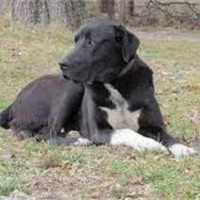Appearance of the Great Pyredane
|
| The Great Pyredane is a giant breed of dog, generally measuring over 61 centimeters high at the shoulder and often weighing over 45 kilos. They usually have a large rectangular head, but it's not usually heavy in relation to the animal's body. Their medium-sized, almond-shaped eyes are usually brown, but sometimes lighter colors like blue, and the ears are set high on the skull and fold forward, falling close to the cheek. The tail is generally long and straight like the Great Dane's, but they can also have a "shepherd's hook" in their tail, a trait passed down from the Mountain Dogs of the Pyrenees. Although they can inherit all the coat characteristics of the parent breeds, most Great Pyredanes seem to have the soft, short, glossy coat of the Great Dane, but many also sport a short, dense undercoat passed down from Pyrenean Mountain Dogs. |
Temperament of the Great Pyredane
|
| The Great Pyredane is a popular hybrid, recognized by most hybrid and designer dog registries. This giant dog tends to be more reserved and independent than the Great Dane, but more sensitive and eager to please than the Pyrenean Mountain Dog. These dogs tend to be quite tolerant of children and other animals in their household and are generally calm enough not to send toddlers flying with their antics, but all interactions between children and dogs must be carefully supervised for the safety of both child and dog, and children should never be allowed to ride the Great Pyredane as this can aggravate certain disorders such as hip dysplasia and Wobbler syndrome. Although they are generally gentle and easy-going with their own families, some Great Pyredanes can inherit the guarding tendencies of Pyrenean Mountain Dogs and become somewhat overprotective of children or other animals in their herd. |
Needs and activities of the Great Pyredane
|
| These large dogs generally have fairly low exercise requirements to stay fit and healthy, and are usually quite content with several short exercise sessions equivalent to around 40 to 60 minutes of vigorous exercise a day. The mature Great Pyredane is generally a fairly calm animal around the house, although some can be prone to bursts of very energetic behavior. However, the adolescent can be more boisterous than the adult, and care must be taken to ensure that the dog doesn't put too much strain on its joints during its critical growth phases. These dogs are generally not suited to apartment living due to their vocal nature, energetic outbursts and size. |
Maintenance of the Great Pyredane
|
| This crossbreed generally has fairly simple grooming requirements, as both parent breeds have coats that tend to shed dirt and water, virtually eliminating the need for regular bathing, unless the dog gets into something objectionable, even for dogs that inherit the thick coat of Pyrenean Mountain Dogs. The Great Pyredane tends to shed all year round, and regular brushing is necessary to remove dead hairs and keep the coat supple and healthy, usually at least two or three times a week. This dog's large, pendulous ears can be slightly prone to developing infections, so they need to be cleaned and assessed regularly. |









 English (United Kingdom)
English (United Kingdom)